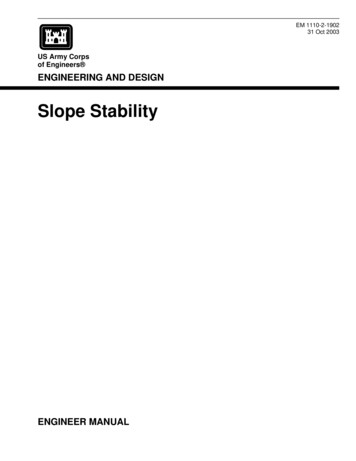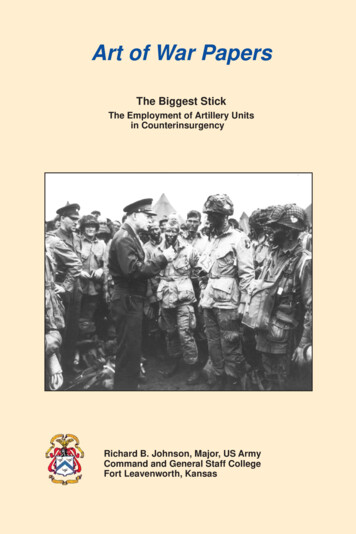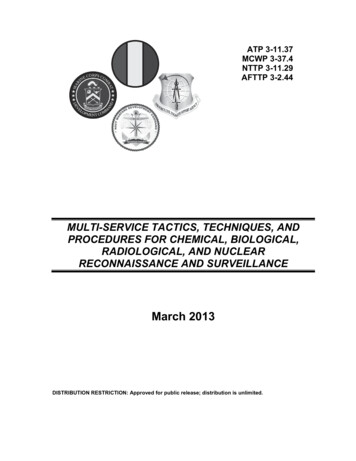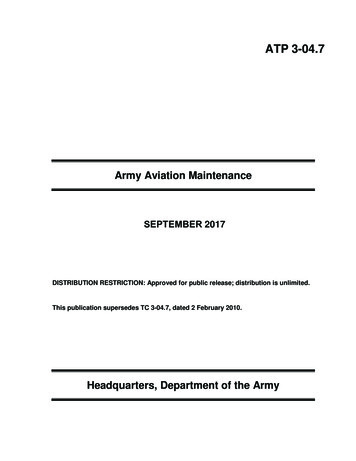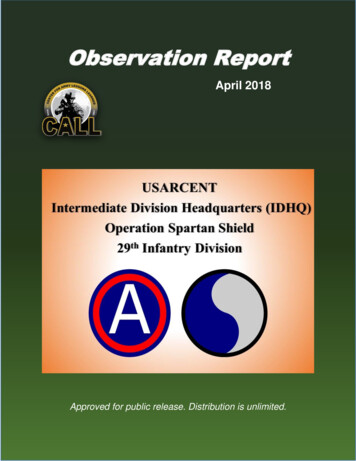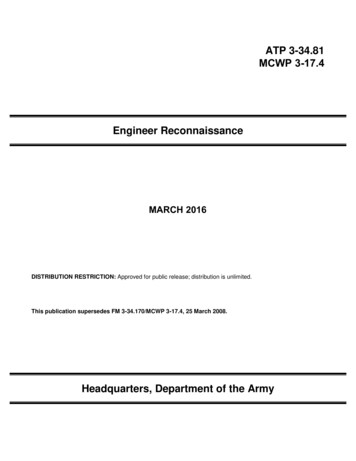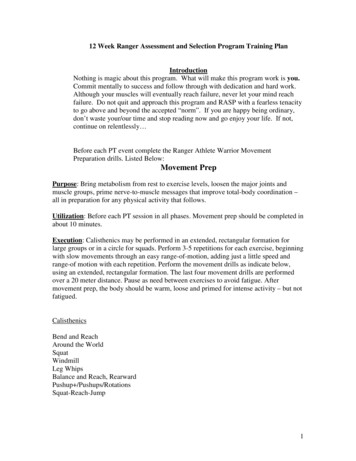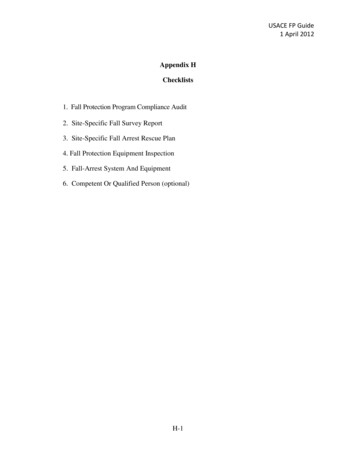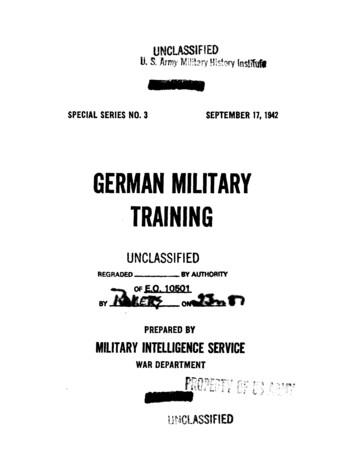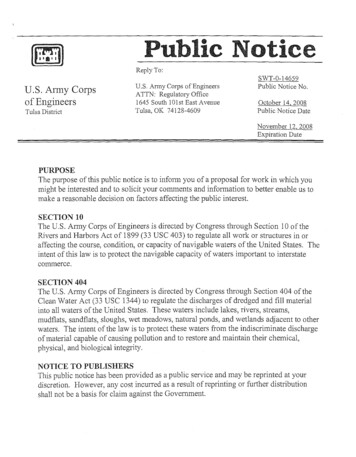
Transcription
PublicoticeReply To:U.S. Anny Corpsof EngineersTulsa DistrictU.S. Army Corps of EngineersATTN: Regulatory Office1645 South 101 st East AvenueTulsa, OK 74128-4609SWT-0-14659Public Notice No.October 14, 2008Public Notice DateNovember 12,2008Expiration DatePURPOSEThe purpose of this public notice is to infOlID you of a proposal for work in which youmight be interested and to solicit your comments and information to better enable us tomake a reasonable decision on factors affecting the public interest.SECTION 10The US. Army Corps of Engineers is directed by Congress through Section 10 oftheRivers and Harbors Act of 1899 (33 USC 403) to regulate all work or structures in oraffecting the course, condition, or capacity of navigable waters of the United States. Theintent of this law is to protect the navigable capacity of waters important to interstatecommerce.SECTION 404The US. Army Corps of Engineers is directed by Congress through Section 404 oftheClean Water Act (33 USC 1344) to regulate the discharges of dredged and fill materialinto all waters of the United States. These waters include lakes, rivers, streams,mudflats, sandflats, sloughs, wet meadows, natural ponds, and wetlands adjacent to otherwaters. The intent of the law is to protect these waters from the indiscriminate dischargeof material capable of causing pollution and to restore and maintain their chemical,physical, and biological integrity.NOTICE TO PUBLISHERSThis public notice has been provided as a public service and may be reprinted at yourdiscretion. However, any cost incurred as a result of reprinting or further distributionshall not be a basis for claim against the Goverrnnent.
DEPARTMENT OF THE ARMYCORPS OF ENGINEERS, TULSA DISTRICT1645 SOUTH 101ST EAST AVENUETULSA, OKLAHOMA 74128-4609Application No. SWT-0-14659JOINT PUBLIC NOTICEU.S. Army Corps of Engineers, Tulsa DistrictandTexas Commission on Environmental Quality(3D-DAY COMMENT PERIOD)Interested parties are hereby notified that the DistrictEngineer has received an application for a Department of the ArmyPermit under Section 404 of the Clean Water Act (CWA).Theapplication is to construct a dam on Bois d'Arc Creek to impounda water supply reservoir, Lower Bois d'Arc Creek Reservoir.Thepurpose of the work is to expand water supply resources of theNorth Texas Municipal Water District.Name of Applicant:Mr. James ParksExecutive DirectorNorth Texas Municipal Water District (NTMWD)505 East Brown StreetP.O. 2408Wylie, TX 75098Name of Authorized Agent: Mr. Michael VotawFreese & Nichols, Inc.4055 International Plaza, Suite 200Fort Worth, TX 76109-4895Location: In Bois d'Arc Creek, approximately 14 miles northeastof the town of Bonham, in Fannin County, Texas.The center ofthe darn is located at Latitude 33 43' OS" and Longitude -95 0 58'56". The project site can be found on the Selfs, Texas 7.5Minute USGS Quadrangle map.The extent of the proposedimpoundment pool includes portions of the following 7.5 MinuteUSGS Quadrangle maps: Bonham, Dodd City, Lake Bonham, andLamasco.Applicant's Statement of Purpose: The purpose of the proposedproject is to impound the waters of Bois d'Arc Creek and itstributaries to create a new water supply reservoir for NTMWD.The NTMWD provides wholesale treated water supply, wastewatertreatment, and regional solid waste services to member cities andcustomers in a service area covering all or parts of Collin,Dallas, Denton, Fannin, Hunt, Kaufman, Rains, and RockwallCounties in north central Texas.State population projections
show the NTMWD service population to increase from 1.6 million to3.3 million by 2060.This growing population is the drivingforce for increased demands for water, and the need to developnew sources of water supply. The Lower Bois d'Arc CreekReservoir would provide a new water supply to help meet thisincreasing demand.Description of WorkDam and Reservoir:Lower Bois d'Arc Creek Reservoir Dam would beconstructed as a zoned earthen embankment. The dam would beabout 10,400 feet in length and would have a maximum height ofabout 90 feet.The design top elevation of the embankment wouldbe 553.5' msl. The embankment would provide 19.5 feet offreeboard above the conservation pool of Lower Bois d'Arc CreekReservoir, at elevation 534.0' msl, and approximately three feetof freeboard above the Probable Maximum Flood (PMF) elevation of550.5' msl. The upstream and downstream side slopes would be3.5 horizontal to one vertical. All fill for the embankment isexpected to come from required excavations of the spillways andfrom the reservoir pool area. Soil cement would be placed on theupstream slope and a grass cover would be placed on thedownstream slope.Preliminary drawings of the proposed dam andspillways are presented on Figure 2 (Encl 14659-2).Type and AmountLocationHoney GroveCreekBois d'ArcCreekWetlands Abutting Boisd'ArcCreekTOTALof Fill Material to be Discharged(cubic ice Spillway and Outlet Works:The service spillway would belocated at the right (east) abutment of the dam (Figure 2).Thespillway would consist of an approach channel; a 150-footuncontrolled concrete weir, chute, hydraulic jump stilling basinand outlet channel. The weir would consist of a concretegravity, ogee-type section with a crest length of 150 feet.Thecrest of the weir would control the conservation pool level whichwould be at elevation 534.0' msl, and the weir would have adischarge capacity of about 37,300 cfs at the maximum designwater surface, the PMF, elevation 550.5' msl.The spillwaystructure would extend 958 feet downstream from the centerline ofthe dam to the downstream edge of the end sill. A hydraulic jumpstilling basin would be constructed with baffle blocks and an end2
sill. The stilling basin would be at elevation 456.0' msl and itwould be 128 feet long.service spillway discharges would beconveyed to Honey Grove Creek by a discharge channelapproximately 2,300 feet long with a 150-foot bottom width andthen flow approximately 1,500 feet to Bois d'Arc Creek.Required low-flow releases would be made through a 36-inchdiameter low-flow outlet located on the right (east) side of thefloodplain near the toe of the right abutment.The conduit wouldextend through the dam and would have an impact basin as anenergy dissipation structure.Its exit channel would extend tothe service spillway exit channel and then back to Bois d'ArcCreek. The outlet would include a multiple-level intake tower inthe reservoir to allow for required downstream releases.An emergency spillway would be located in the right abutmentof the dam (Figure 2).The spillway would be a 1,400-foot wideuncontrolled broad crested weir structure with a crest elevationof 541' msl. This elevation was selected to contain the 100-yearstorm such that no flow passes through the emergency spillwayduring this event.Preliminary drawings of the dam, service spillway, and outletworks are attached showing several views of the proposedstructures, as follows: Encl 14659-1 - Vicinity and Location MapEncl 14659-2 - Reservoir and Diversion Dam MapEncl 14659-5 - plan and Profile Drawing of Dam andService SpillwayPlan and Profile Drawing of EmergencyEncl 14659-6 SpillwayEncl 14659-7 - Typical Dam and Low-Flow Outlet SectionDrawingsEncl 14659-8 - Service Spillway Plan and Section DrawingsRaw Water Transmission Facilities: Raw water from the reservoirwould be transported by a pipeline to a proposed water treatmentplant near the City of Leonard in Fannin County (Figure 3).Toallow the NTMWD the ability to treat water from Lower Bois d'ArcCreek Reservoir at its existing facilities in Wylie, Texas, thepipeline would also extend to an outfall on Pilot Grove Creek, atributary of the East Fork of the Trinity River, to deliver rawwater to Lake Lavon. The outlet structure is expected to belocated approximately 5.4 miles north of Lake Lavon in the reachof pilot Grove Creek between FM 545 and FM 2756.The raw waterwould be transported via the bed and banks of pilot Grove Creekand Lake Lavon to the NTMWD's existing intake structures on LakeLavon.3
The primary pipeline consists of approximately 29 miles of90-inch pipe, a pump station and intake structure at thereservoir, and a 460 million gallon terminal storage reservoirlocated near the new water treatment plant near Leonard.Theprimary pipeline would have an initial capacity of 135 milliongallons per day (mgd) , with an ultimate capacity of 170 mgd.Thedischarge outlet would include approximately 14.4 miles of 66inch pipeline, an outfall structure at pilot Grove Creek, andappropriate controls.The maximum daily discharge to Pilot GroveCreek through the 66-inch pipeline would be 113 mgd.Currently, the final alignment of the raw water transmissionfacilities has not been determined.However, a preliminary routehas been developed and a preliminary jurisdictional evaluationwas completed by Alan Plummer Associates, Inc. (APAI, 2008).Thestudy consisted primarily of desktop analyses using informationsuch as USGS topographic maps, aerial photography, NRCS digitalsoil map data, and National Wetland Inventory (NWI) maps toidentify potential wetlands, streams, and other water bodies thatmay be waters of the U.S. and could be affected by the pipelineconstruction.In addition, field reconnaissance was employed toidentify potentially affected vegetation communities and to makeobservations of stream and wetland characteristics wherefeasible.The results of the evaluation indicated thepreliminary alignment would intersect 15 potential wetlands(5 forested, 10 emergent), 87 streams (3 perennial,41 intermittent, 43 ephemeral), and 16 impoundments(8 on-channel, 8 on uplands).The Corps will be reviewing thesepreliminary determinations of jurisdiction for ultimatedetermination of federal jurisdiction on intersecting streams.Based on the results of the preliminary alignment evaluationfor the pipeline, impacts to waters of the U.S. would likely beunavoidable. However, impacts would be avoided and minimized tothe extent practicable during final design by such means as: adjusting the pipeline alignment to avoid discrete waterbodies such as wetlands and open waters,crossing streams at narrow points and at right angles tominimize crossing lengths, andreducing the construction easement clearing width to theminimum necessary at stream crossings to preserveexisting riparian vegetation.Each of these intersections would represent a single andcomplete crossing, so any impacts to waters of the U.S. could beconsidered independent at each crossing rather than cumulativelyfor the entire pipeline. The NTMWD proposes to follow the termsand conditions of the current (2007) Nationwide Permit 12,4
Utility Line Activities, as the design criteria for the pipelinein order to avoid and minimize impacts where waters of the U.S.are unavoidable Thus, construction of the pipeline would includesuch measures as restoring preconstruct ion contours in waters ofthe U.S.; limiting total impacts at a single crossing to lessthan 0.5 acre with a goal of less than 0.1 acre; and backfillingthe top 6 to 12 inches of the pipeline trench in wetlands withtopsoil from the trench.Therefore, the applicant has requestedthat the pipeline be authorized under the terms and conditions of2007 NWP 12, based on the fOllowing conditions:1. A detailed jurisdictional determination (JD) would beconducted for the pipeline route to allow identification,avoidance, and minimization of impacts to waters of the U.S.prior to final design and construction. The JD report wouldbe submitted to the USACE for approval prior toconstruction.A preconstruction notification (PCN) prepared in accordancewith 2007 NWP General Condition 27 would be submitted to theUSACE for approval prior to construction.This PCN would provideverifiable evidence to the USACE that the proposed pipeline wouldmeet the terms and conditions of 2007 NWP 12.Construction Timino:If authorized, the applicant projectsconstruction of the project commencing in 2013 and beingcompleted in 2016. Construction of the pump station and pipelinewould begin in 2015 and be completed by 2017.Surface Area of Wetlands and Waters Filled: Based on theapplicant's jurisdictional determinations in the project area,construction of the dam and impoundment of the water within thenormal pool elevation of 534' msl would result in direct fillimpact or inundation of approximately 120 acres of perennialstreams, 99 acres of intermittent streams, 87 acres of openwater, 4,602 acres of forested wetlands, 1,223 acres ofherbaceous wetlands, and 49 acres of shrub wetlands.Thelocation of the wetlands and waters of the U.S. are depicted onFigure 4 (The 15 higher detail sheets 4Al through 4El areavailable on a request basis). The Corps is currently reviewingfor verification the jurisdictional determinations anddelineations submitted by the applicant's agent.Mitigation: The applicant proposes the following as potentialcomponents of a conceptual compensatory mitigation plan for theunavoidable impacts to aquatic resources expected from theproposed project:a.b.c.Mitigation bank credit purchase and/or in-lieu fee agreementsIn-stream flow releasesStream restoration and riparian habitat enhancement5
d.Purchase of lands and management for wildlife habitatenhancemente.Private land purchases to expand the Caddo NationalGrasslands within the congressional proclamation boundaryf.Water quality protection measures and shoreline managementplanningg.Creation of waterfowl management areas.The applicant proposes that any additional lands purchased tosupport mitigation purposes be purchased from willing sellers.This mitigation plan is the applicant's proposal and will besubject to refinement through the permit evaluation process.TheCorps of Engineers has made no determination at this time withregard to the adequacy of the proposed mitigation relative tofederal mitigation rules and guidance, including Tulsa District'sMitigation and Monitoring Guidelines. The Corps is acceptingcomments on the need for and nature of the proposed mitigation inaddition to comments on the applicant's primary proposal.TheCorps bears the final decision on the need for and extent ofmitigation required if the project proposed herein is authorized.Project Setting: The proposed project site lies across theboundary between two Level IV Ecoregions, the Northern BlacklandPrairie and the Northern Post Oak Savanna.The BlacklandPrairies have finely textured clay soils and the naturalvegetation is prairie. However, much of the Blackland Prairiehas been converted to cropland or urban uses.The Northern PostOak Savanna, part of the East Central Texas Plains (also known asthe Claypan area) is an area of irregular plains that wereoriginally covered by post oak savanna vegetation.Much of thisarea is currently being used for pasture and rangeland.Thebottom of the Bois d'Arc valley is predominantly bottomlandhardwoods. These bottomland woods have been subject to repeatedcycles of timber cutting, both select cutting and clear cutting,to the point that the remaining timber stands are predominantlycomposed of less merchantable species (green ash, box elder,sugarberry, cedar elm, hackberry, and black willow) .Plans and Other Data: Plans showing the location of the proposedactivity and other data are enclosed with this notice (Encls14659-1 through 14659-8). The application and supplementalmaterials are on file and may be viewed during normal workinghours at the Tulsa District, U.S. Army Corps of Engineers, 1645South 101st East Avenue, Tulsa, Oklahoma.If additionalinformation is desired, it may be obtained from Mr. Andrew R.Commer, U.S. Army Corps of Engineers, Tulsa District, ATTN:Regulatory Office, 1645 South 101st East Avenue, Tulsa, OK74128-4609, or telephone 918-669-7400.6
Cultural Resources: The District Engineer has consulted theNational Register of Historic Places (Register), and it has beendetermined that there are no properties currently listed in theRegister nor any properties which have been determined eligiblefor listing in the Register which would be directly affected bythe proposed work.However, with a project involving this mucharea, encountering previously unknown sites is a possibility andwe will be coordinating with the Texas Historic Commission forcompliance with Section 106 of the National Historic PreservationAct of 1966. Furthermore, if we are made aware, as a result ofcomments received in response to this notice, or by other means,of specific archeological or other historic properties whichmight be affected by the proposed work, the District Engineerwill immediately take the appropriate action necessary pursuantto the National Historic Preservation Act of 1966 (Public Law89-665), as amended, and 36 CFR 800, in accordance withimplementing regulations 33 CPR 325, Appendix C.Environmental Considerations: Our preliminary determination isthat the proposed activity will not affect listed EndangeredSpecies or their critical habitat. A copy of this notice isbeing furnished the U.S. Fish and wildlife Service andappropriate State agencies and constitutes a request to thoseagencies for information on whether any listed or proposed-to-belisted endangered or threatened species may be present in thearea which would be affected by the proposed activity.Authorization from other Agencies: This project would result ina direct impact of greater than three acres of waters of thestate or 1500 linear feet of streams (or a combination of the twois above the threshold), and as such would not fulfill Tier Icriteria for the project.Therefore, Texas Commission onEnvironmental Quality (TCEQ) CWA Section 401 water qualitycertification is required.Concurrent with processing of thisapplication, the TCEQ is reviewing this application under Section401 of the Clean Water Act and in accordance with Title 30, TexasAdministrative Code Section 279.1-.13, to determine if the workwould comply with State water quality standards. By virtue of anagreement between the u.s. Army Corps of Engineers (Corps) andthe TCEQ, this public notice is also issued for the purpose ofadvising all known interested persons that there is pendingbefore the TCEQ a decision on water quality certification undersuch act. Any comments concerning this application may besubmitted to the TCEQ, 401 Coordinator, MSC-150, P.O.Box 13087,Austin, Texas 78711-3087. The public comment period extends 30days from the date of the publication of this notice. A copy ofthe public notice with a description of work is made availablefor review in the TCEQ's Austin office. The complete applicationmay be reviewed in the Corps office. The TCEQ may conduct apublic hearing to consider all comments concerning water qualityif requested in writing. A request for a public hearing must7
contain the following information: the name, mailing address,application number, or other recognizable reference to theapplication; a brief description of the interest of therequester, or of persons represented by the requester; and abrief description of how the application, if granted, wouldadversely affect such interest.The decision whether to issue a permit will be based on anevaluation of the probable impact, including cumulative impacts,of the proposed activity and its intended use on the publicinterest. That decision will reflect the national concern forboth protection and utilization of important resources.Thebenefit which reasonably may be expected to accrue from theproposal must be balanced against its reasonably foreseeabledetriments.All factors which may be relevant to the proposal will beconsidered including the cumulative effects thereof; among thoseare conservation, economics, aesthetics, general environmentalconcerns, wetlands, cultural values, fish and wildlife values,flood hazards, flood plain values, land use, navigation, shoreerosion and accretion, recreation, water supply and conservation,water qual
Oct 14, 2008 · Raw Water Transmission Facilities: Raw water from the reservoir would be transported by a pipeline to a proposed water treatment plant near the City of Leonard in Fannin County (Figure 3). To allow the NTMWD the ability to treat water from Lower Bois d'Arc Creek
